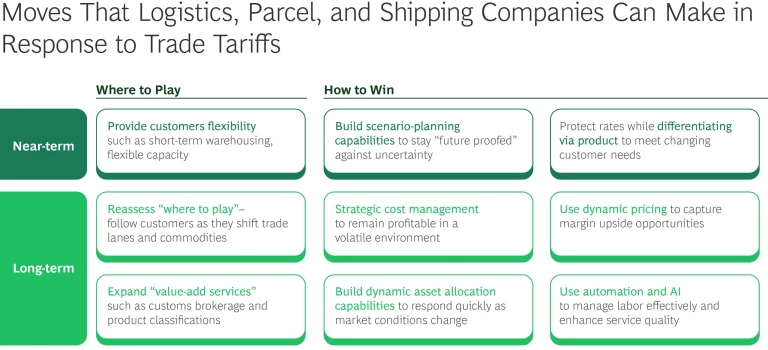Note: The tariff environment is in a constant state of change. The purpose of this article is not to outline any specific tariff rule, but rather to offer a perspective on how to manage a business within logistics, parcel, and shipping with a longer-term set of outcomes in mind, factoring in the uncertain future of tariff and trade policy.
Recent shifts in US trade policy have created both challenges and opportunities for players in the logistics, parcel, and shipping (LPS) sector. Tariffs directly impact shippers by raising the total landed cost of their products entering the US; the second-order effect falls on the transportation companies that facilitate the global flow of these goods. While ongoing diplomatic efforts are underway to negotiate tariff rates, the outlook remains volatile—requiring LPS companies to develop near- and longer-term strategies to insulate against this uncertainty while simultaneously pursuing advantage.
The new US tariffs—and countermoves by other countries—have far-reaching implications. Everything from global freight volumes and rates to the business models of online retailers are feeling the effects. Based on BCG’s recent survey of logistics industry leaders, nearly 80% of shippers have reported cost increases from tariffs and duties, and almost 70% of shippers hope to cut shipping costs—with contract renegotiation as their primary lever.
For companies that form the backbone of global supply chains, navigating this landscape requires agility, strategic foresight, and a collaborative approach with the shippers they serve. The industry must act quickly. For example, nearly half of logistics companies surveyed are already adapting operations to potential nearshoring. LPS companies must continue adapting or risk being left behind.
Recalibrating Global Trade Flows
One of the most significant effects of tariffs is the potential redirection of global trade. The historically high-volume trade lane from China to the US faces sustained pressure as businesses seek to further diversify their supply chains. As companies establish new sourcing locations and trade relationships in Southeast Asia, Mexico, and the broader Global South, logistics providers must prepare for a potential long-term restructuring of global supply chains.
Stay ahead with BCG insights on transportation and logistics
This recalibration also alters the mix of commodities being shipped and the services required to move them. For instance, a strategic move to re-shore or near-shore manufacturing in the US may increase demand for raw material imports while changing the nature of finished good flows. What’s more, the growing complexity of cross-border trade creates the need for increased value-added services, such as warehousing and trade management and consulting support.
Air and Ocean Players Caught in the Middle
The most immediate and direct impact of these tariffs is felt by international ocean and air transportation providers. Tariffs are a key variable in calculating the total landed cost—the full price of a product once it arrives at the buyer’s door. As such, they directly shape decisions about where goods are manufactured, how much is produced and shipped, and which trade lanes are used.
The policy implications vary considerably by commodity type. Product categories such as fashion and luxury goods have greater tariff exposure than others, such as semiconductors and biopharmaceuticals. This is driven both by the tariff policy and the country of origin for these products. Beyond the tariffs themselves, regulations like the Section 301 port entry fees on Chinese-built or -operated vessels add another layer of complexity. Because these fees are applied per vessel, they disproportionately affect lower-cost goods, representing a larger percentage of their total value and creating additional challenges for these market segments.
From a pricing perspective, the market is bracing for volatility. A short-term rush to build up inventories could lead to a spike in airfreight and ocean rates. Over the longer-run, freight rates may face downward pressure as shippers push logistics providers for lower rates to offset higher duties, and—in the case of a softer economic environment—reduced consumer and business demand.
To manage through this uncertainty, international carriers can employ tactics like redeploying assets to new geographies, canceling scheduled trips (“blank sailing”), or slowing down vessels to reduce fuel consumption and better balance supply with demand (“slow steaming”). They can also focus on the opportunity in value-added services (such as trade management and HS classification), and asset-light providers can take margin in the short term if they expect future freight rates to fall.
Ripple Effect on US Domestic Transport Players
For domestic transportation providers—including truckload, less-than-truckload (LTL), rail, and intermodal services—the tariff impact is more indirect. But it’s no less significant. These players participate in the domestic leg of international transportation and will be directly impacted by any headwinds on volume. Further, the risk of stagflation—the combination of sluggish growth and rising inflation— and reduced consumer sentiment could translate to reduced investment by US businesses. This could further hurt an already soft domestic logistics environment reeling from the squeeze on freight transportation.
Despite the challenging backdrop, domestic players can seize the opportunity to strengthen their position. Specifically, they must prioritize strategic cost management and leverage automation, AI, and dynamic pricing to enhance efficiency and capture margin. They can also differentiate by innovating their product portfolio to meet changing customer needs.
The De Minimis Disruption: A Shift for Parcel and Facilitators
Perhaps the most disruptive single policy change is the recent termination of the de minimis exemption. This rule, which allowed goods valued under $800 to enter the US duty-free, was the secret sauce for the “fast fashion” e-commerce playbook run by players like Shein and Temu.
The impact of this rule was staggering; between 2017 and 2024, the number of de minimis entries into the US skyrocketed from approximately 330 million to around 1 billion annually. However, as of May 2, 2025, this exemption was terminated. In its place, tariffs have been imposed. While the initial proposed tariff of 120% (or $200 per package) was reduced, the current rate of 54% (or $100 per package) still marks an abrupt shift from the previous duty-free environment.
This policy change is forcing a re-evaluation of supply chains for low-value goods. Some shifts in modes of transportation are expected, with shippers likely to move a portion of volume from air freight to bulk shipping via ocean cargo to cut costs. The sharp hike in consumer prices may also lead to a decline in the demand for certain low-value parcels, as consumers have less purchasing power.
LPS providers have an opportunity to work closely with direct-to-consumer shippers that face challenges due to the de minimis exemption cancellation. Logistics providers can offer support by shifting customer cargo from air freight to cheaper ocean services. They can also provide any needed warehousing and storage capacity in the US for goods that were previously sent directly to the customer. And they can offer value-added services such as trade management and customs brokerage to ensure compliance with the new regulations.
A Strategic Framework for Success
Even in this turbulent environment, logistics, parcel, and shipping companies have options. A proactive strategy will help them not only weather the current challenges but find new opportunities for growth and competitive advantage. The objective is to become a more integrated—and vital—partner to shippers. (See the exhibit.)

In the short run, these companies must stay nimble. This includes offering solutions like temporary warehousing near ports and maintaining flexible capacity to meet fluctuating demand. They must also build robust scenario-planning capabilities to prepare for further tariff changes. And they can stand out by tailoring their products to meet shifting customer needs.
Over the longer term, LPS providers must regularly reassess their market position. This means following customers as they shift manufacturing and sourcing to new countries and trade lanes. They can also lean into the growing complexity of international trade by offering specialized services like customs brokerage and Harmonized System (HS) product classification. Further, players should look to strengthen their position through strategic cost management, automation, dynamic pricing, and dynamic asset allocation capabilities.
Ultimately, the path forward for the logistics sector is one of proactive partnership and adaptation. By investing wisely and employing a full suite of strategic levers, transportation providers can navigate tariff uncertainty—and other geopolitical risks in the news—and emerge as indispensable partners to the shippers who depend on them.






